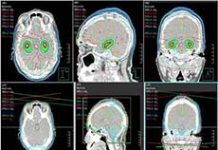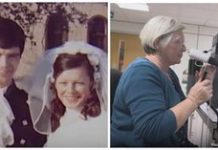We’ve sent robots to mars, split the atom and mapped the human genome. Why, then, is there still so much more to understand about a disease that affects one in two of us? Leading cancer researchers explain their quest to understand cancer at the end of life.
Written by Katharine Latham for Guardian Labs
 Getty Images
Getty Images
“It was like they were just going to sleep,” says Martin Ledwick. For many years he worked on cancer wards, sitting with people while they were dying. Now, as our head information nurse, managing its telephone helpline and online forum Cancer Chat, this is what Ledwick tells callers who ask about cancer at the end of life.
Usually patients become more and more sleepy, he says, and less able to get out of bed. Eventually, they slip into a state of unconsciousness, which can go on for a while before they die.
“The questions [people ask] are many and varied, but ultimately they want to know what is going to happen,” he says. “We can give them a broad picture of what often happens and what the possibilities are.
“There are still many misconceptions. A lot of people think cancer is a death sentence; these days it really isn’t. And many expect dying with cancer to be painful and undignified. I reassure people that as long as they have good palliative care, most of the symptoms should be controllable; that they or their loved one will be comfortable.”
Looking for answers
People often find it difficult to talk about death – but it’s something we will all experience.
“When I first started nursing, people didn’t mention cancer, let alone death and dying,” says Ledwick. “Over the past 20 years, we’ve become much more open about these things. Being able to talk about death enables people to ask the questions they need to ask.”
Scientists, too, are looking for answers. They continue to make new discoveries all the time, but there is still so much they don’t understand. “We know very little about how cancer causes death,” says Dr Mariam Jamal-Hanjani, a cancer researcher at the University College London (UCL) Cancer Institute and a medical oncologist at University College London Hospitals (UCLH), where she treats people with lung cancer. “We know patients die after cancer spreads, but we don’t know why – although we do have some ideas.”
Cancer is complex. It’s not just one disease – but hundreds. Every cancer has sub-types, and the millions of cancer cells within a single tumour can be very different from each other. As these cancer cells grow and divide, their genetic mutations lead to a multitude of changes in how they behave. Understanding the way cancer evolves over the course of a person’s illness could shed light on the mechanisms that cause death.
 100vw, 300px”></p>
<p class=) DNA samples for genetic profile testing. Image Credit: Getty Images
DNA samples for genetic profile testing. Image Credit: Getty Images
What we think we know
Cancers by their nature are heterogeneous, or genetically diverse, and they evolve as they grow and every time a person undergoes treatment. “One theory is that cancer can go into overdrive. It becomes so genetically chaotic that it somehow drives the biology of dying. Possibly,” says Jamal-Hanjani.
Another theory is that, as cancer spreads and the burden of disease becomes very great, it develops multiple pathways of resistance to treatments. Then the organs begin to fail.
“The liver stops working, the heart or lungs fail, or because of a tumour you bleed in the brain,” says Jamal-Hanjani. “That may be physiologically why the patient dies, but we don’t know how cancer is driving that process. And some of our patients don’t have much disease on board but still die of their cancer. So something else must be driving death in those people.”
Something like immune exhaustion, which happens when the immune system has been fighting for so long that it just can’t go on. “Your immune system should recognise cancer cells as foreign and attack them before they have a chance to propagate, divide and grow,” says Jamal-Hanjani.
 100vw, 200px”></p>
<p class=) Dr Mariam Jamal-Hanjani
Dr Mariam Jamal-Hanjani
But while some cancer cells can escape recognition by the immune system, there’s also a phenomenon called immune exhaustion, where over time the immune cells become less able to recognise cancer cells, allowing them to flourish and multiply unhindered.
Finally, there is a phenomenon in cancer called cachexia, a wasting syndrome where muscle and fat is lost, impacting a person’s quality of life and ability to tolerate cancer treatments.
People with cachexia often die from heart failure due to loss of heart muscle, or from lung failure as respiratory muscles waste away, leaving breathing compromised. “Somehow metabolism in the body is rewired in favour of the cancer, as opposed to the patient, and we do not know what is driving this process.
“Even if you feed the patient intravenously, this process is not reversed, suggesting that the cancer cells may somehow redirect the extra calories and energy to benefit themselves.”
How we’re trying to find out
Scientists need to understand how cancer evolves and spreads and to do that they need access to tissue samples. But as cancer progresses, it becomes increasingly difficult to study. “By the time patients have metastatic disease, they can be quite unwell,” says Jamal-Hanjani.
“The cancer may have spread to different sites in the body, such as the brain. You can’t easily take tissue samples from the brain – it’s invasive and can be dangerous for patients. We know brain metastases increase the chances of death significantly and that we need to understand more about the biology that leads to this.”
It was almost 10 years ago that Jamal-Hanjani and her colleague, Prof Charles Swanton, group leader at the Francis Crick Institute and co-director of the charity’s Lung Cancer Centre of Excellence, first discussed the idea of research autopsies. “When Charlie suggested it I thought: ‘Who’s going to want to do this? How could we possibly broach such a sensitive subject with our patients?’,” says Jamal-Hanjani, who is a visiting scientist at Francis Crick.
Despite this, with nearly £4m funding from Cancer Research UK, the Posthumous Evaluation of Advanced Cancer Environment (PEACE) study was launched in 2016, and has subsequently grown into a national autopsy programme for people who die of cancer.
Everything we learn for decades to come will be their legacy
Dr Mariam Jamal-Hanjani
So far, the PEACE team, which includes laboratory scientists, clinicians and data analysts, has recruited more than 300 people with several different types of cancer, and carried out over 180 autopsies.
With each autopsy, researchers analyse samples from the original tumour, organs to which the cancer may have spread, and cancer cells and DNA found in blood samples, enabling an extraordinarily detailed picture to be built up of a person’s cancer. The plan is to collect postmortem samples from up to 500 people who have died from their disease.
“We have access to an unprecedented amount of tissue,” says Jamal-Hanjani. “We can collect many samples from many sites: the brain, the lungs, the heart, the abdomen. The more samples we look at, the more we can grasp just how heterogeneous these tumours can become and what complex pathways they can adopt to spread across the body.”
 100vw, 300px”></p>
<p class=) Small cell carcinoma, a type of cancer commonly seen in the lung. Image credit: Getty Images
Small cell carcinoma, a type of cancer commonly seen in the lung. Image credit: Getty Images
The team hopes to gain a timeline of biological changes from diagnosis to death – to understand how tumours develop and spread, why and how tumours become resistant to treatment, and how the body reacts to the disease during the final stages.
Indeed, findings so far have been eye-opening. Early data from the PEACE study shows that as cancer spreads, it evolves continually, in multiple directions from multiple sites.
“It’s giving us real insight into how complex metastatic disease is,” says Jamal-Hanjani. “We’re also seeing parallel evolution. While different populations of cancer cells evolve independently, there does seem to be a preference for certain genetic pathways – order in the chaos.
“The more samples we look at, from more patients and more autopsies, I’m really hopeful that we’ll find commonalities that will give us some idea of what we can do in terms of offering people treatments that can help prevent, or at least slow down, the spread of cancer.”
She adds: “Some patients are resolute that they want to give their body to cancer research. That’s incredibly humbling. Everything we learn for decades to come will be their legacy.”
 100vw, 200px”></p>
<p class=) Eileen Rapley
Eileen Rapley
‘I wanted to have the last word’
In 2016, at the age of 73, Eileen Rapley was diagnosed with lung cancer. “This is it,” she thought.
But after undergoing surgery, radiosurgery, immunotherapy and radiotherapy at UCLH, her disease is now stable. During her treatments, she signed up to both the PEACE and TRACERx studies. One of the aims of TRACERx, also funded by Cancer Research UK, is to map the differences between individual cancer cells within tumours, tracking lung cancer evolution in unprecedented detail.
Rapley hopes the trials will lead to earlier diagnoses and “kinder treatments”. “It was nice to think my having cancer could be of use. And I wanted to have the last word – not the cancer.”
‘To carry on his legacy’
When Mark Sims was diagnosed with skin cancer at the age of 15, he was determined to make the most of every moment. Before his death in 2017, at the age of 28, he had qualified as a doctor, met the love of his life, been best man at his twin brother’s wedding and achieved his ambition to visit all 28 countries of the EU by the age of 28.
After his diagnosis, Sims underwent surgery, then, when the cancer spread, he was given targeted cancer drugs to prolong his life and even saw his tumours begin to shrink. When his cancer became resistant to that treatment, he received immunotherapy.
Sims, who had enrolled in the PEACE study, dedicated much of his free time to raising money for Cancer Research UK. By the time he died, his online donation page had raised more than £100,000 for the charity.
“I’m determined to carry on his legacy and raise money in the hope of saving future lives,” says Sue Sims, Mark’s mother.
It was because of the many treatments developed through cancer research that Sims was able to survive for so long after his diagnosis – well beyond the five years doctors had originally hoped for. He, in his turn, left behind a scientific and financial legacy that he hoped would benefit others, giving them the chance to live longer too.
You can get support from others affected by cancer using our fully moderated online community at cancerchat.org.uk, or speak to a CRUK nurse on freephone 0808 800 4040 9-5 Mon-Fri.
Dr Jamal-Hanjani’s work is featured in Cancer Revolution: Science, innovation and hope, a free exhibition opening at the Science Museum in London in May 2022. The exhibition, which we were an expert partner for, reveals the past, present and future of how cancer is prevented, detected and treated. To book free tickets, visit https://www.sciencemuseum.org.uk/see-and-do/cancer-revolution-science-innovation-and-hope
This article was originally published on theguardian.com as part of the Cancer Research UK and Guardian Labs Cancer revolutionaries campaign.






